Please refer to Class 12 Physics Sample Paper Term 2 With Solutions Set A provided below. The Sample Papers for Class 12 Physics have been prepared based on the latest pattern issued by CBSE. Students should practice these guess papers for class 12 Physics to gain more practice and get better marks in examinations. The Term 2 Sample Papers for Physics Standard 12 will help you to understand the type of questions which can be asked in upcoming examinations.
Term 2 Sample Paper for Class 12 Physics With Solutions Set A
SECTION – A
1. Ultraviolet radiations of different frequencies u1 and u2 are incident on two photosensitive materials having work functions W1 and W2 (W1 > W2) respectively. The kinetic energy of the emitted electrons is same in both the cases. Which one of the two radiations will be of higher frequency?
Answer: 1/2 mv2max = hv1 −W1 = hv2 −W2
or h(v1– v2 ) = W1 – W2
or h(v1 – v2) = positive [∵ W1 > W2]
or v1 – v2 = positive
so v1 > v2
2. State de Broglie hypothesis. Is it applicable for moving electron of hydrogen atom ?
OR
Calculate the de-Broglie wavelength of the electron orbiting in the n = 2 state of hydrogen atom.
Answer: de-Broglie hypothesis : It states that a moving particle sometimes acts as a wave and sometimes as a particle or a wave is associated with moving particle which controls the particle in every respect. The wave associated with moving particle is called matter wave or de-Broglie wave whose wavelength is given by
λ= h/mv
where m and v are the mass and velocity of the particle and h is Planck’s constant.
Yes, it is applicable for moving electron of hydrogen atom.
OR
Kinetic energy of the electron in the second state of hydrogen atom
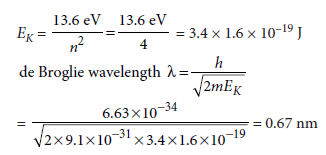
3. Plot a graph showing variation of current versus voltage for the material Gas.
Answer: Variation of current versus voltage for Gas.

4. If A is the angle of prism, r angle of refraction, then what is the condition for minimum deviation?
OR
Find the magnifying power of a convex lens of focal length 10 cm when the image is formed at the near point.
Answer:

As r1 + r2 = A
At minimum deviation, r1 = r2 = r
∴ 2r = A
OR
(d) : When the final image is formed at the near point, the magnifying power is m= 1+D/f
where D is the least distance of distinct vision and f is the focal length of the convex lens.
Here, D = 25 cm, f = 10 cm
∴ m=1+ 25 cm/10 cm =1+ 2. 5= 3.5
5. In a double slit experiment, when light of wavelength 400 nm was used, the angular width of the first minima formed on a screen placed 1 m away, was found to be 0.2°. What will be the angular width of the first minima, if the entire experimental apparatus is immersed in water? (mwater = 4/3)
Answer: Angular width for first minima in Young’s double slit experiment, θ = λ/a

For question numbers 6-7, two statements are given-one labelled Assertion (A) and the other labelled
Reason (R). Select the correct answer to these questions from the codes (a), (b), (c) and (d) as given below.
(a) Both A and R are true and R is the correct explanation of A
(b) Both A and R are true but R is not the correct explanation of A
(c) A is true but R is false
(d) A is false and R is also false
6. Assertion (A) : The depletion layer in the p-n junction is free from mobile charge carriers.
Reason (R) : There is no electric field across the junction barrier.
Answer:
C
7. Assertion (A) : Young’s double slit experiment can be performed using a source of white light.
Reason (R) : The wavelength of red light is less than the wavelength of other colours in white light. c
Answer:
C
SECTION – B
8. is a Case Study based question and it is compulsory. Attempt any 4 sub parts from this question. Each part carries 1 mark.
Refraction through Spherical Surfaces
Answer: Refraction of light is the change in the path of light as it passes obliquely from one transparent medium to another medium. According to law of refraction sin sin, i/sin r=1μ2, where 1m2 is called refractive index of second medium with respect to first medium. From refraction at a convex spherical surface, we have μ2/v -μ1/u= μ2- μ1/R . Similarly from refraction at a concave spherical surface when object lies in the rarer medium, we have μ2/v -μ1/ μ2- μ1/R and when object lies in the denser medium, we have μ1/v -μ2/u =μ1- μ2/R
.
(i) Refractive index of a medium depends upon
(a) nature of the medium
(b) wavelength of the light used
(c) temperature
(d) all of these
Answer:
D
(ii) A ray of light of frequency 5 × 1014 Hz is passed through a liquid. The wavelength of light measured inside the liquid is found to be 450 × 10–9 m. The refractive index of the liquid is
(a) 1.33
(b) 2.52
(c) 2.22
(d) 0.75
Answer:
A
(iii)A ray of light is incident at an angle of 60° on one face of a rectangular glass slab of refractive index 1.5. The angle
of refraction is
(a) sin–1(0.95)
(b) sin–1(0.58)
(c) sin–1(0.79)
(d) sin–1(0.86)
Answer:
B
(iv) A point object is placed at the centre of a glass sphere of radius 6 cm and refractive index 1.5. The distance of the virtual image from the surface of sphere is
(a) 2 cm
(b) 4 cm
(c) 6 cm
(d) 12 cm
Answer:
C
(v) In refraction, light waves are bent on passing from one medium to the second medium because in the second medium
(a) the frequency is different
(b) the co-efficient of elasticity is different
(c) the speed is different
(d) the amplitude is smaller.
Answer:
C
SECTION – C
9. Calculate the energy in fusion reaction :21H+21H→32He+n,
where B.E. of 21H=2.23 MeV.and of 32he=7.73 meV
Answer: Fusion reaction, 21H+21H→ 32He+ n
Energy released = final B.E. – initial B.E.
= 7.73 – (2.23 + 2.23) = 3.27 MeV.
10. The work function for a certain metal is 4.2 eV. Will metal give photoelectric emission for incident radiation of wavelength 330 nm ?
OR
If the momentum of an electron is changed by p, then the de Broglie wavelength associated with it changes by 0.5%. What will be the initial momentum of electron ?
Answer: Let us calculate the energy associated with incident photons

So, energy of incident photons i.e., 3.77 eV is less than work function, hence emission will not take place.
OR
de Broglie wavelength associated with an electron is
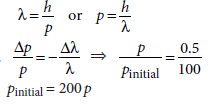
11. A plane electromagnetic wave travels in vacuum along z-direction. What can you say about the direction of electric and magnetic field vectors?
Answer: The electric and magnetic field vectors →E and →B are perpendicular to each other and also perpendicular to the direction of propagation of the electromagnetic wave.
If a plane electromagnetic wave is propagating along the z-direction, then the electric field is along x-axis, and magnetic field is along y-axis.
12. The forbidden energy gap in semiconductors, insulators and metals are Es, Ei, and Em respectively. Arrange these in descending order. The band gap in silicon is 1.12 eV. What is the maximum wavelength of light that can be emitted by it?
OR
In the following diagram, is the junction diode forward biased or reverse biased?

Answer:
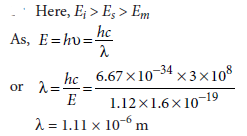
OR
Voltage at p side is less than voltage at n side of the diode so it is in reverse bias
SECTION – D
All questions are compulsory. In case of internal choices, attempt any one.
13. Write any two distinguishing features between conductors, semiconductors and insulators on the basis of energy band diagrams.
Answer: The band diagram for conductors, semiconductors and insulators are given as follows:

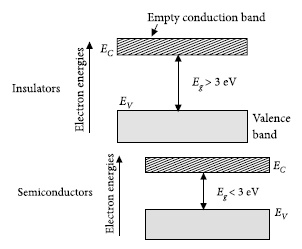
Two distinguishing features :
(i) In conductors, the valence band and conduction band tend to overlap (or nearly overlap) while in insulators they are separated by a large energy gap and in semiconductors they are separated by a small energy gap.
(ii) The conduction band of a conductor has a large number of electrons available for electrical conduction.
However, the conduction band of insulators is almost empty while that of the semiconductor has only a (very)
small number of such electrons available for electrical conduction.
14.A convex lens made of a material of refractive index m1 is kept in a medium of refractive index m2. Parallel rays of light are incident on the lens. Complete the path of rays of light emerging from the convex lens if
(a) μ1 > μ2 (b) μ1 = μ2 (c) μ1 < μ2
OR
The radius of curvature of the curved surface of a plano-convex lens is 20 cm. If the refractive index of the material of the lens be 1.5, then show that it will act as a convex lens irrespective of the side on which the object lies.
Answer: In case (a) μ1 > μ2, the lens behaves as convergent lens.
In case (b) μ1 = μ2, the lens behaves as a plane plate.
In case (c) μ1 < μ2, the lens behaves as a divergent lens.
The path of rays in all the three cases is shown in the figure.
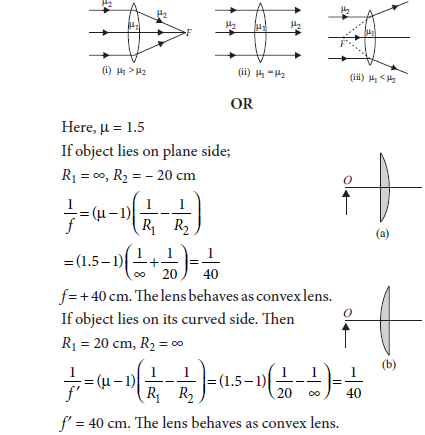
SECTION – E
All questions are compulsory. In case of internal choices, attempt any one.
15. A parallel beam of monochromatic light falls normally on a narrow slit of width ‘a’ to produce a diffraction pattern on the screen placed parallel to the plane of the slit.
Use Huygens principle to explain that
(i) the central bright maxima is twice as wide as the other maxima.
(ii) the intensity falls as we move to successive maxima away from the centre of on either side.
OR
(a) Two monochromatic waves emanating from two coherent sources have the displacements represented by
y1 = a cos wt and y2 = a cos (wt + Φ)
where f is the phase difference between the two displacements. Show that the resultant intensity at a point due to their superposition is given by I = 4 I0 cos2 f/2, where I0 = a2.
(b) Hence obtain the conditions for constructive and destructive interference.
Answer:

Consider a parallel beam of monochromatic light is incident normally on a single slit AB of width a as shown in the figure. According to Huygens principle every point of slit acts as a source of secondary wavelets spreading in all directions. The mid point of the slit is O. A straight line through O perpendicular to the slit plane meets the screen at C. At the central point C on the screen, the angle q is zero. All path differences are zero and hence all the parts of the slit contribute in phase. This gives maximum intensity at C.
Consider a point P on the screen.
The observation point is now taken at P.
Secondary minima : Now we divide the slit into two equal halves AO and OB, each of width a/2 . For every point, M1 in AO, there is a corresponding point M2 in OB, such that M1 M2 a/2= . The path difference between waves arriving at P and starting from M1 and M2 will be a /2 sinθ = λ/2asinθ=λ
In general, for secondary minima asinq = nl where n = ±1, ±2, ±3…… Secondary maxima
: Similarly it can be shown that for secondary maxima asinθ= (2n +1)λ/2 where n = ±1, ±2……..
The intensity pattern on the screen is shown in the given figure.
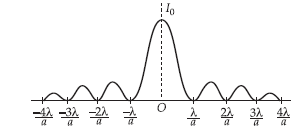
Width of central maximum = 2Dλ/a
(ii) The reason is that the intensity of the central maximum is due to the constructive interference of wavelets from all parts of the slit, the first secondary maximum is due to the contribution of wavelets from one third part of the slit (wavelets from remaining two parts interfere destructively), the second secondary maximum is due to the contribution of wavelets from the one fifth part only (the remaining four parts interfere destructively) and so on. Hence the intensity of secondary maximum decreases with the increase in the order n of the maximum.
or
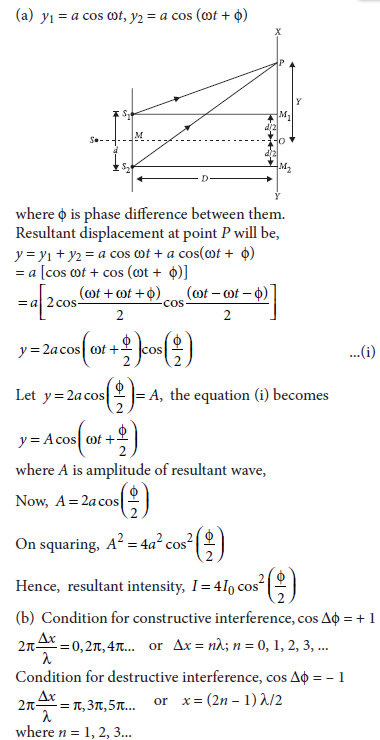
16. (a) Using Bohr’s atomic model, derive the expression for the radius of nth orbit of the revolving electron in a hydrogen atom.
(b) Write two important limitations of Rutherford nuclear model of the atom.
OR
(a) Using de Broglie’s hypothesis, explain with the help of a suitable diagram, Bohr’s second postulate of quantization of energy levels in a hydrogen atom.
(b) The ground state energy of hydrogen atom is –13.6 eV. What are the kinetic and potential energies of the electron in this state?
Answer: (a) Radius of nth orbit of hydrogen atom : In H-atom, an electron having charge –e revolves around the nucleus of charge +e in a circular orbit of radius r, such that necessary centripetal force is provided by the electrostatic force of attraction between the electron and nucleus

From Bohr’s quantization condition
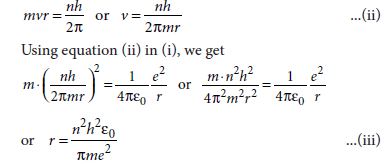
where n = 1, 2, 3, … is principal quantum number.
Equation (iii), gives the radius of nth orbit of H-atom. So the radii of the orbits increase proportionally with n2 i.e., [r ∝ n2]. Radius of first orbit of H-atom is called Bohr radius a0 and is given by

(b) The two important limitations of Rutherford nuclear model of the atom are :
(i) This model cannot explain about the stability of matter.
(ii) It cannot explain the characteristic line spectra of atoms of different elements.
OR
(a) According to de Broglie, a stationary orbit is that which contains an integral number of de Broglie waves associated with the revolving electron.
For an electron revolving in nth circular orbit of radius rn,Total distance covered = Circumference of the orbit = 2 πrn
∴ For the permissible orbit, 2πrn = nλ
According to de-Broglie,


We hope you liked the above provided Class 12 Physics Sample Paper Term 2 With Solutions Set A. Incase you want more sample papers please click on the links below.
